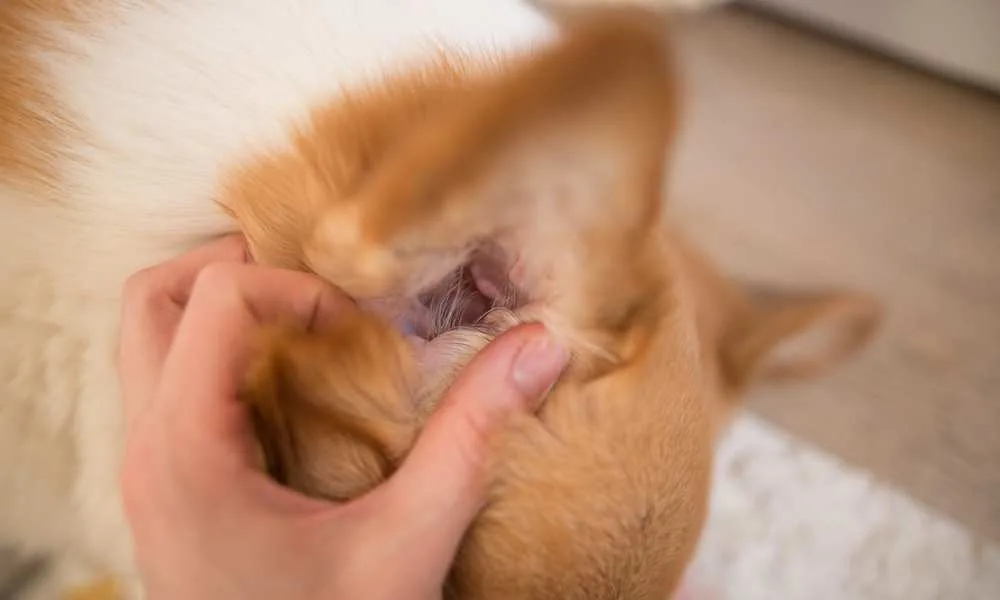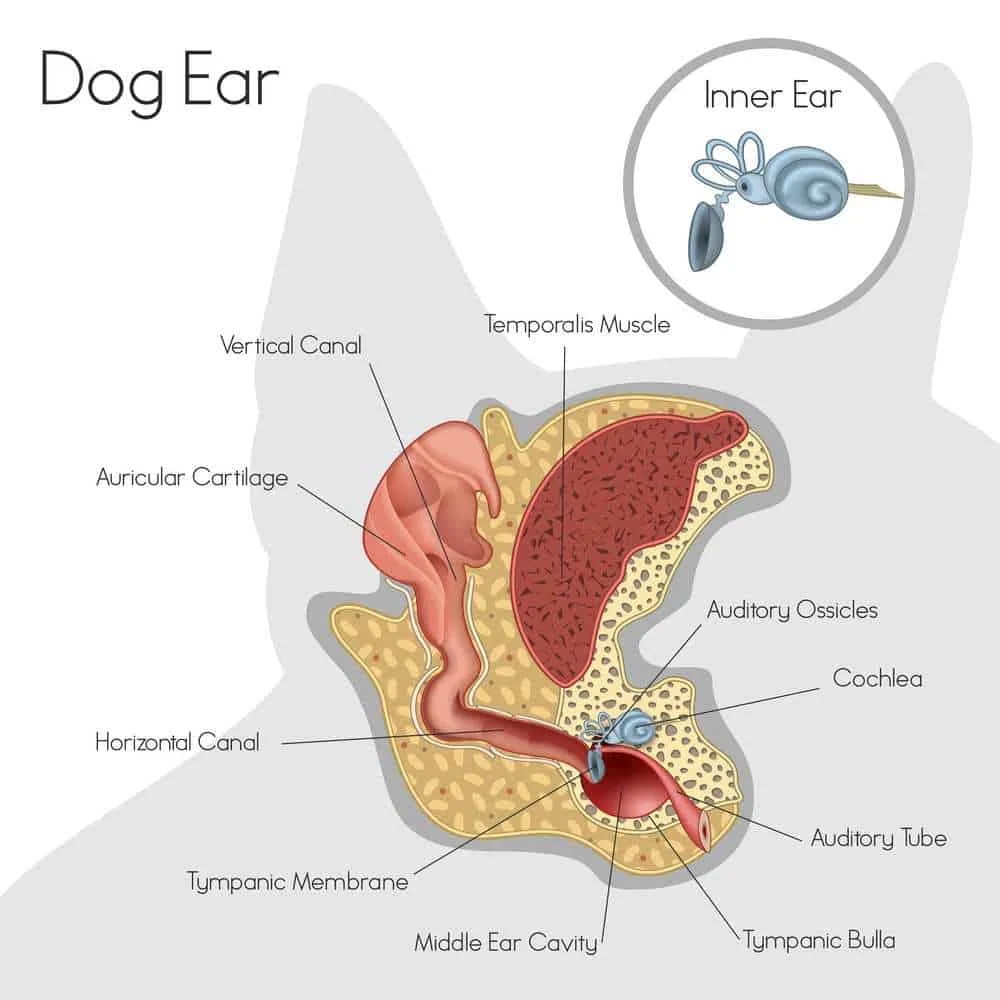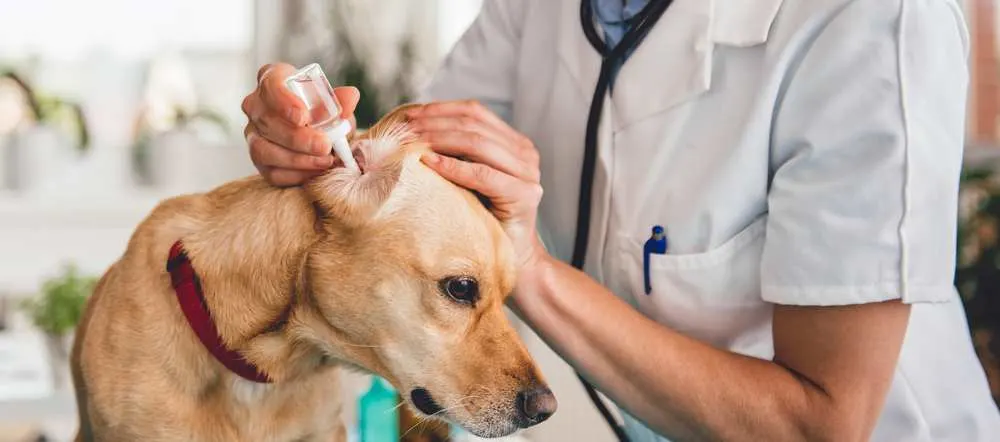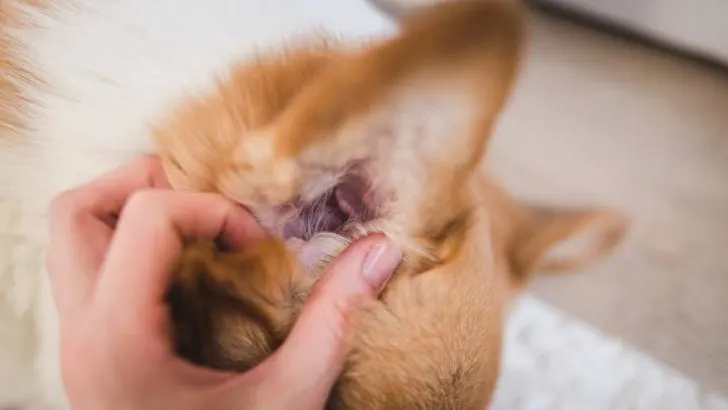Grooming your Corgi, well, any dog in general, is a hard task, but it is crucial. When I say grooming, I bet most Corgi owners think about trimming the coat, regular bathing, or clipping the nails, but that is not entirely true. Regular grooming routine should as well include ear cleaning and eye cleaning.
Did you know that ear infection is the second most common reason for a vet visit? Now logically, you all think, well, we will clean their ears more frequently, and everything will be alright. Hm, yes and no.
Just remember how hard it was for your parents to clean your ears when you were a kid; it is exactly the same with pups; they do not allow it! However, it is important to take the time and effort and learn how to clean Corgi ears so your pooch won’t develop an ear infection.

Are Corgis Prone To Ear Infections?
All dogs, including Corgis, have warm and moist ears, which present the perfect ground for bacteria and microorganisms such as yeast to develop.
When your Corgi is running through the tall grass or rolling on the ground, small bits and pieces of grass, dirt, and all kinds of debris get their way into the ears and wrack the havoc. Ear infection, if left untreated, may cause hearing loss.
Some dogs naturally have healthy and clean ears and may never be at risk of getting an ear infection and only need to have their ears cleaned from time to time. On the other hand, some breeds with long hanging ears, like Basset Hounds, are super prone to infections, and they need regular and thorough ear cleaning to prevent the buildup of debris and dirt. But what about Corgis?
Do Corgis have sensitive ears?
Yes, they do, but not as much as long ear breeds do; the problem is that Corgis are prone to some other health issues that lead to ear infections, like skin allergies, ear mites, ear tumors, and hypothyroidism.

How To Tell When It’s Time To Clean Your Dog’s Ears?
When it comes to cleaning your dog’s ears, how often should you do that? Before you reach out for an ear cleaner, check if your puppy’s ears actually need cleaning. You can always under-clean or over-clean your dog’s ears.
Under-cleaning will allow infection-causing yeast and bacteria to build up. When you over-clean your Corgis ear, you will strip away a healthy coat of ear wax, leading to irritation, and irritated ears are more likely to get infected.
Checking the health of your Corgis ears is something you should be doing regularly. If your dog loves to swim and does frequently do, it is highly recommended that you keep their ear canals dry and well ventilated using topical astringents.
Clean ears are pink, odorless, not inflamed, with no dirt traces. You can assess their condition by gently rubbing them. If they are healthy, your Corgo will probably enjoy having his ears rubbed, but if he pulls away, they may be sore and irritated. When you notice a mild odor or your Corgi is shaking his head more often, it might be time for the cleaning.
These symptoms could indicate an ear infection, ear mites, fleas, and allergies that require medical attention. Cleaning an infected ear at home usually causes more harm than good, so consult your vet as soon as possible.

What Is The Cause Of A Dog’s Smelly Ears?
There are a lot of different things that can cause your dog’s ears to become smelly. Here I will mention only the most common causes:
Ear Wax Buildup
Ear wax buildup occurs when a normal self-cleaning mechanism is disturbed, and it can be difficult to notice since your dog might not be bothered by this at all. The ear wax will be yellow in color, and the excess amount of it will cause a change in odor in your Corgis ears. The problem can usually be solved by cleaning your dog’s ears with an adequate ear-cleaner.
Yeast Infections
Ear yeast infections are very common, and they can cause a significant odor in your dog’s ears. Yeast infection is a result of the overproduction of Candida in your dog’s body, and usually, it causes a sweet or musty smell; it is very distinctive. You should keep an eye on redness and discharge from the ear that will be brown in color.
Yeast infections should be treated by the vet since, in some cases, they need to perform cytology to diagnose this problem. Treatment includes antifungal drops or an ear cleaner, and in severe cases, an oral antifungal medication. If you doubt yeast infection, do not clean your dog’s ears for 24 hours prior to your appointment. Clean ears make a diagnosis more difficult.
Bacterial Ear Infections
A bacterial ear infection usually is the most severe of them all. Never clean your dog’s ears at home before seeing your veterinarian if you doubt bacterial ear infection. Certain types of bacteria are so smelly that you will be able to smell the ear from across the room, followed by redness, swelling, and pain.
The discharge will be pus and a blood-tinged fluid or both. Cytology is necessary to confirm the presence of bacteria. Bacterial ear infections are treated with antibiotic ear drops and oral antibiotics. If the infection is so severe as to cause swelling in the ear, oral steroids should be prescribed to reduce pain and swelling.
Mixed Ear Infections
Mixed ear infections are common, where the symptoms can vary, depending on the types and numbers of organisms present.
It is crucial to learn how to recognize signs of a severe middle ear infection. The symptoms you should take an eye on are:
- If your dog appears to be off-balance
- If your dog seems uncoordinated and confused
- If your dog turns in circles and acts lost
This is a serious infection, and it requires to be seen by a vet immediately since these ear infections are often the underlying condition of some other issue.
The Anatomy Of A Dog’s Ear

You should familiarize yourself with your dog’s ear anatomy before you decide to clean them on your own. This will prevent any damage and hurt. A dog’s ear is a bit complex.
That cute visible outside flap of the ear is called the pinna, and in some dogs, it will flop while in others, it stands up straight. Floppy ears allow less airflow to the ear canal, so dogs with this type of ears are more prone to ear infections.
Inside the ear is a visible opening of the external canal; this canal travels down the side of the head and then takes a turn inward. The canal is covered with skin and contains cartilage that creates creases on the surface that are a bit tricky to clean. The external canal contains glands that secrete wax and oils into the ear.
The external canal ends with the tympanic membrane, which is a thin piece of tissue that vibrates in response to sound waves, protects the middle and inner ear, and enhances hearing – beyond that membrane in the middle ear, followed by the inner ear. Here are placed delicate structures associated with hearing and balance.
It is important to know the anatomy of a dog’s ear since damage to the inner or middle ear can cause a lot of trouble to the sense of hearing and balance, and that damage can even be permanent.

Ear Cleaning Process And Supplies
How To Clean Corgi Puppy Ears?
Well, first, you must prepare to clean your Corgis ears. Ear cleaning, while simple, can get pretty messy. The best places for cleaning your dog’s ears are the tub or outside.
Keep in mind that when you clean your dog’s ears, he will shake its head, and all that ear debris and cleaner will end up on your walls, so the bathroom is the best option. Prepare some towels to dry yourself as well to wrap a towel around your dog and place one under it to keep the floors dry.
Before you start cleaning the ears, inspect them well to make sure how dirty they are. Always check for excess hair; if there is a lot of hair coming out from the ear canal, it should be plucked; you can do this with your fingers, tweezers, or hemostats.
It’s recommended to talk with your vet or groomer about properly plucking the hair and avoiding hurting your pup. There is a special ear powder made for dogs that may be helpful in gripping the hair, so consider using it.
You only need a few things to successfully clean your dog’s ears:
- Cotton ball or gauze
- Dog ear-cleaning solution
- Towel
Do not use cotton-tipped swabs or anything with a pointed tip since they can shove dirt and debris deeper into your dog’s ears. This can cause infections and even lead to trauma of the inner structures of the ear.
Dog Ear-cleaning Solutions
Veterinarian-approved ear-cleaning solutions are the safest choice, even though homemade cleaning ear solutions are very popular now. Some homemade ear-cleaning solutions contain harmful and irritating ingredients, so it is better to avoid them and stick with the safe options.
Ask your vet what product they recommend for your dog breed, not all solutions work well for some breeds, and that is normal. Some are more beneficial for your pup’s specific needs than others, do research and consult your vet.
Clean Your Corgis Ears In 3 Easy Steps
Be patient and pick out the best moment to clean your dog’s ears; wait until he/she is calm, as this will help make the process way easier. Use favorite treats to sweeten the deal and make your upper eager to cooperate.
Gently squeeze an ear-cleaning solution to fill your dog’s ear canal; this won’t be pleasant for your pup, but hang on. Now massage gently at the base of the ear for at least 30 seconds. Do not be afraid it is normal to hear a squishing sound as the product dislodges debris and buildup.
Never let the tip of the applicator touch your Corgis ear, as this can introduce bacteria!
Let your dog shake his head and use the towels to protect yourself from spray and to wipe down his face. When the shaking head is at rest, take the cotton ball or gauze and easily wipe out the ear canal. Never go deeper than the depth of one knuckle.
If you notice your dog is uncomfortable or he is experiencing pain during this process, call your vet.
What About Using Hydrogen Peroxide To Clean Dog Ears?
Don’t use hydrogen peroxide on your pup since it can cause irritation to healthy skin cells, which can lead to an ear infection. Ear tissue is very sensitive, and extended use of hydrogen peroxide could eventually lead to damage to the ear itself. Stick to veterinarian-approved cleaners since they are gentle enough to not harm the skin’s pH yet to remove dirt effectively.

How Often Should I Clean My Corgis Ears?
If your dog’s ears need cleaning to prevent recurrent ear infections, the best thing to do is to consult your vet and see what he has to say. It is very easy to over-clean your pup’s ears and damage the skin’s natural balance.
However, these are some guidelines you should follow:
- Regular ear cleaning should be performed once every 2–4 weeks.
- If a dog gets regular ear infections, clean the ears every 1–2 weeks.
- In case the cotton wool comes out clean, wait for two weeks before cleaning again, but if the cotton wool is mucky, clean the ears again the next day. Suppose the cotton wool is still mucky the next day, then clean for a 3rd day. If ears are still dirty, it is time to see the vet.
This way, you will be able to spot an early ear infection and seek help before it becomes too late.

Summary
Regular grooming of your Corgi will prevent all sorts of issues and infections. Make sure you always pay good attention to your puppy’s eyes and ears, even if it is not the time for trimming the nails and coat. They are especially vulnerable, and they are sustainable to infections.
Dogs can build up wax and debris at a faster rate than we do but do not forget that wax coating has a role in protecting the ear from bacteria and debris. It is important to use an appropriate ear cleaner to release wax and debris from the canal and help dry the ear.

